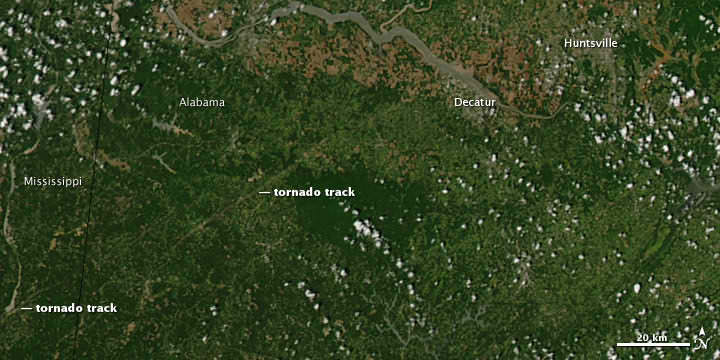[/caption]
Some extraordinary satellite and radar imagery shows how the deadly tornado supercell slashed through Alabama and Mississippi last week, as in the image above, leaving a gash of exposed ground and destruction that is visible from space. The latest reports indicate fatalities from the outbreak now exceed 342 people, and according to the Washington Post, this is the most people killed by tornadoes in a two-day period since April 5-6, 1936 when 454 people died. The image was taken by the Moderate Resolution Imaging Spectroradiometer (MODIS) on NASA's Aqua satellite on April 28. See more imagery below.
[caption id="attachment_85337" align="aligncenter" width="537" caption="Part of the path of a 12-mile swath of destruction in Alabama from an EF4 tornado on April 27. Click to see the entire swath taken by a NOAA satellite. Credit: NOAA"]
[/caption]
The National Weather Service said an EF4, with winds around 175 miles per hour, created a 12-mile-long track of destruction. This tornado caused more than 20 deaths.
[caption id="attachment_85339" align="aligncenter" width="452" caption="Radar sequence of tornado supercell thunderstorms that tracked from western Mississippi into southwest North Carolina. Credit: NCAR, Brian Tang. "]
[/caption]
This image is pretty amazing: it is a radar montage of the supercell showing some of the 150 tornadoes that were reported on April 27 and 28, 2011. This cell traveled about 450 miles and lasted over 8 hours.
This animation from the NASA Earth Observatory team starts on April 26 and runs through the morning of April 28. It shows a relatively stable mass of cold air—visible as a swirl of more-or-less continuous clouds—rotates in the north along the top of the image, and meanwhile, moist air pushes north and west from the Atlantic Ocean and Gulf of Mexico. The two air masses collide and generate severe weather, but the bad weather also was amplified by the jet stream on April 27, which helped generate the lines of intense thunderstorms and tornadoes.
Sources:
NASA Earth Observatory,
Washington Post
, NOAA
 Universe Today
Universe Today
